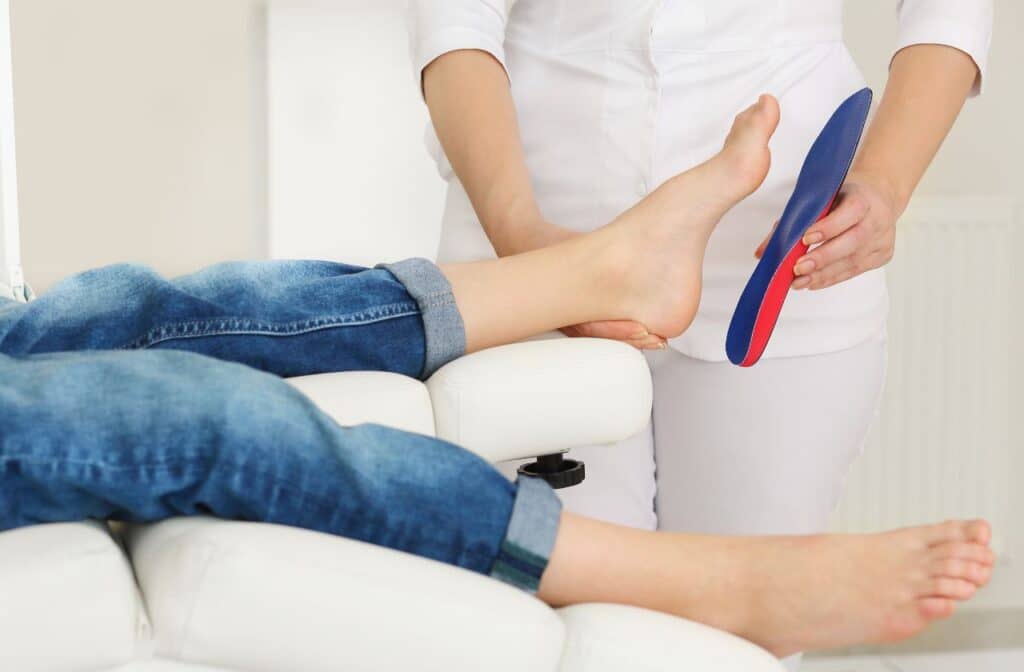Foot pain is a common issue that affects everyone, from athletes to office workers. Whether caused by plantar fasciitis, heel pain, or general discomfort, the right orthotic can provide much-needed relief. However, with so many choices available, deciding between custom-made and over-the-counter orthotics can be challenging. Research findings on custom vs. standard orthotics highlight key differences in their effectiveness, durability, and overall benefits, helping individuals make more informed choices.
The debate primarily centers on cost, comfort, and medical necessity. Custom-made orthotics offer precision and long-term advantages, while over-the-counter options provide affordability and accessibility. But which one is truly the best? Let’s explore the evidence and real-world experiences to find out.
Custom vs. Standard Orthotics: Which to Choose?

Understanding Orthotics and Their Role
What are Orthotics?
Orthotics are devices designed to support and alter foot function. They help improve biomechanics, correct gait issues, and reduce pain caused by heel spurs, plantar fasciitis, and flat feet. Whether custom-made or mass-produced, these foot orthoses provide cushioning, off-loading, and pressure relief for people dealing with foot conditions. Learn more about the science behind arch support.
How Do They Work?
The biomechanical mechanism of orthotics is simple: they distribute body weight, support the joints, and improve balance. Studies in the British Journal of Sports Medicine have shown that orthotics can aid in load redistribution, preventing overuse injuries common in physically active individuals like running athletes. They are often prescribed for conditions like diabetic plantar ulceration, juvenile idiopathic arthritis, and rheumatoid arthritis to enhance function and improve quality of life. You can explore more about research on orthotics and knee pain relief.
Standard (Over-the-Counter) Orthotics
What Are They?
Over-the-counter orthotics are prefabricated foot insoles designed for general foot sizes. Unlike custom-made orthotics, they don’t require a plaster cast or three-dimensional laser scan. These non-prescription inserts are available in pharmacies, online, and retail stores, making them a convenient choice for quick pain relief.
Benefits of Standard Orthotics
One of the biggest advantages of over-the-counter orthotics is their affordability. Ranging from $20 to $80, they are much cheaper than custom orthotics. They are also easily accessible, requiring no medical care or referral. For people with mild foot discomfort, these orthotics can serve as an adjunct to other treatments like stretching exercises, rest, ice, and painkillers.
Limitations of Standard Orthotics
However, over-the-counter orthotics follow a one-size-fits-most approach. They are mass-produced and lack the personalized biomechanical support that some conditions require. While they provide temporary relief, they may not address underlying pathogenesis, particularly in cases of chronic fasciopathy. Their shorter lifespan (6 months to 1 year) means frequent replacements, adding to the long-term cost. A recent study on insole effectiveness highlights the differences in outcomes between standard and custom insoles.

Custom Orthotics: Precision and Personalization
What Are Custom Orthotics?
Custom-made orthotics are designed for individual foot structures based on biomechanical assessments. They help manage pronated foot, hallux valgus, and other lower limb problems by redistributing weight bearing during standing, walking, and running. These orthotics are created using plaster casts or three-dimensional laser scans, ensuring a precise fit.
Benefits of Custom Orthotics
One of the key benefits is medical-grade correction. Unlike prefabricated options, custom-made orthotics address underlying biomechanical issues like overpronation, joint misalignment, and foot instability. Clinical research shows they can improve function and provide long-term pain relief, particularly for diabetic patients and individuals with chronic heel pain. They also last much longer—3 to 5 years with proper care. Clinical trials involving shoe inserts further support their effectiveness.
Limitations of Custom Orthotics
The biggest drawback? Cost. Custom orthotics can range from $300 to $800, making them a significant investment. They also require a podiatrist assessment, often involving a clinical trial to ensure proper fit. Some users may experience temporary discomfort as their feet adjust to the new support mechanism.
Key Differences: Custom vs. Standard Orthotics
| Feature | Custom Orthotics | Standard Orthotics |
| Cost | $300–$800 | $20–$80 |
| Fit | Personalized | Generic |
| Durability | 3–5 years | 6 months – 1 year |
| Effectiveness | High for medical issues | Moderate for general comfort |
| Availability | Requires podiatrist | Available OTC |
| Biomechanical Support | High | Low to Moderate |
| Best For | Chronic pain, foot conditions | Temporary relief, mild discomfort |
Biomechanical Impact: Why Custom Orthotics Matter
Foot misalignment can affect the entire body, leading to knee pain, back pain, and poor posture. Custom orthotics help correct gait issues by redistributing pressure relief across the foot structures. They improve dynamic balance, reducing the strain on weight-bearing joints and preventing further injuries.
Many running athletes rely on custom-made orthotics to improve function and prevent injury recurrence. Research in systematic reviews supports their role in reducing load redistribution, particularly in people with chronic foot complaints. Read more about the evidence-based benefits of using insoles for foot pain relief.
Scientific Research: Custom vs. Standard Orthotics
A clinical study in a Dutch general practice found that custom orthoses significantly reduced pain severity on the Numerical Rating Scale compared to sham insoles. However, in a pragmatic design study, over-the-counter orthotics provided similar pain relief in some cases.
While some systematic reviews highlight the clinical effectiveness of custom-made orthotics, others point to conflicting evidence in their cost-effectiveness. This is why general practice physicians often recommend standard orthotics as an initial therapy, reserving custom-made options for recalcitrant plantar fasciitis or severe foot deformities.
Cost vs. Value: Is Custom Worth the Price?
While custom orthotics are expensive, they last longer and provide targeted treatment. If someone has activity-limiting pain, investing in custom-made may be the best treatment option. For those needing short-term relief, prefabricated options can be a cost-effective alternative.
Insurance and Coverage for Orthotics
Many insurance plans cover custom orthotics, particularly for conditions like diabetic plantar ulceration. Patients can seek reimbursement through Flexible Spending Accounts (FSA) or Health Savings Accounts (HSA). Coverage varies, so it’s best to check policy details before purchasing.
Real-World Case Studies: Who Benefits More?
- Athletes: Use custom-made orthotics to enhance performance and prevent overuse injuries.
- Diabetic Patients: Require custom-made orthotics to prevent foot ulcers and protect sensitive tissue.
- Office Workers: Benefit from standard orthotics for temporary relief during prolonged standing and walking.
How to Choose the Right Orthotics for Your Needs
Factors like budget, foot condition, and activity level play a role in selecting the right foot orthoses. If pain persists despite using over-the-counter options, a podiatrist referral may be needed for a custom-made solution. Testing and adjustments can ensure maximum comfort and effectiveness. Expert opinions on insole use can help guide your decision.
People Also Asked about Research findings on custom vs. standard orthotics
Are Custom Orthotics really worth the cost?
Yes, custom-made orthotics are worth the investment for people with chronic foot pain, plantar fasciitis, overpronation, or diabetic foot complications. They provide long-term pain relief, better foot alignment, and improved function compared to over-the-counter insoles. While they cost between $300 and $800, they last 3–5 years, making them more cost-effective in the long run.
Can over-the-counter Orthotics help with plantar fasciitis?
Over-the-counter orthotics can provide temporary relief for plantar fasciitis by offering cushioning and pressure relief to the heel and plantar fascia. However, they may not correct biomechanical imbalances or provide adequate support for severe cases. If symptoms persist despite using prefabricated orthotics, a custom-made solution may be necessary.
How do I know if I need Custom Orthotics?
You may need custom-made orthotics if you experience persistent foot pain, recurring heel pain, arch discomfort, or difficulty walking or running. Conditions like flat feet, high arches, diabetic neuropathy, and fasciopathy often require tailor-made support. If pain severity worsens despite using standard insoles, a podiatrist assessment is recommended.
Do Orthotics help with knee and back pain?
Yes! Foot misalignment can lead to knee, hip, and lower back pain due to improper weight distribution. Custom orthotics help by correcting gait imbalances, providing better shock absorption, and reducing strain on the joints. Many studies suggest that properly designed foot orthoses can improve posture, load redistribution, and overall musculoskeletal function.
Can I wear Orthotics in any type of shoe?
Most over-the-counter and custom orthotics fit into sneakers, walking shoes, and casual footwear. However, some dress shoes or heels may not have enough space for full-length insoles. In such cases, low-profile or slim-fit custom orthotics can be designed specifically for tight-fitting footwear.



